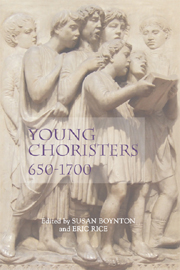Book contents
- Frontmatter
- Contents
- List of Illustrations
- List of Musical Examples
- Acknowledgements
- Dedication
- Introduction: Performance and Premodern Childhood
- 1 The Boy Singers of the Roman Schola Cantorum
- 2 Boy Singers in Medieval Monasteries and Cathedrals
- 3 The Musical Education of Young Girls in Medieval English Nunneries
- 4 Choirboys in Early English Religious Drama
- 5 From Mozos de coro towards Seises: Boys in the Musical Life of Seville Cathedral in the Fifteenth and Sixteenth Centuries
- 6 The Seeds of Medieval Music: Choirboys and Musical Training in a Late-Medieval Maîtrise
- 7 Choirboys in Cambrai in the Fifteenth Century
- 8 Choirboys and Vicaires at the Maîtrise of Cambrai: A Socio-anthropological Study (1550–1670)
- 9 Choirboys, Memorial Endowments and Education at Aachen's Marienkirche
- 10 Thomas Mulliner: An Apprentice of John Heywood?
- 11 Cantando tutte insieme: Training Girl Singers in Early Modern Sienese Convents
- 12 Choirboys in Early Modern Rome
- General Bibliography
- Index
11 - Cantando tutte insieme: Training Girl Singers in Early Modern Sienese Convents
Published online by Cambridge University Press: 12 September 2012
- Frontmatter
- Contents
- List of Illustrations
- List of Musical Examples
- Acknowledgements
- Dedication
- Introduction: Performance and Premodern Childhood
- 1 The Boy Singers of the Roman Schola Cantorum
- 2 Boy Singers in Medieval Monasteries and Cathedrals
- 3 The Musical Education of Young Girls in Medieval English Nunneries
- 4 Choirboys in Early English Religious Drama
- 5 From Mozos de coro towards Seises: Boys in the Musical Life of Seville Cathedral in the Fifteenth and Sixteenth Centuries
- 6 The Seeds of Medieval Music: Choirboys and Musical Training in a Late-Medieval Maîtrise
- 7 Choirboys in Cambrai in the Fifteenth Century
- 8 Choirboys and Vicaires at the Maîtrise of Cambrai: A Socio-anthropological Study (1550–1670)
- 9 Choirboys, Memorial Endowments and Education at Aachen's Marienkirche
- 10 Thomas Mulliner: An Apprentice of John Heywood?
- 11 Cantando tutte insieme: Training Girl Singers in Early Modern Sienese Convents
- 12 Choirboys in Early Modern Rome
- General Bibliography
- Index
Summary
IN one of his gossipy letters from 1697, the Sienese aristocrat Fabio Spannocchi described for Cardinal Francesco Maria de' Medici, the absent governor of Siena, the ceremony to welcome a new novice into one of the city's convents:
Yesterday evening at the door of that same convent [of Monnagnese], which faces the palace of Your Highness, those little nuns performed the most beautiful polyphony as the bride made her entrance into the cloister.
Spannocchi's description of the singers as “little nuns” (monachine) seems not at all remarkable when one remembers that he, along many other writers of the time, employed the word cantarine to refer to fully grown female opera singers. The diminutive can also be found in earlier records from female sacred institutions. The historical chronicles from the institution of Santi Abbondio e Abbondanzio, for example, label the performers at the 1564 consecration ceremony as citole or “little girls.” Although it could be argued that such diminutives were a stylistic tic of the age, it is also possible that, in this case, they acknowledge the youth of the performers in question. Indeed, the nunnery provided one of the few places in early modern Italy where one might regularly hear the characteristic timbre of girls' voices, either as soloists or in a choir. The tender age at which female children were placed in convents suggests that the majority received a thorough musical training there, one that enabled them to enchant even a cynical and experienced dilettante such as Fabio Spannocchi, among others.
- Type
- Chapter
- Information
- Young Choristers, 650–1700 , pp. 195 - 215Publisher: Boydell & BrewerPrint publication year: 2008

